With their unique and unusual appearances, the Moonfish, Wobbegong Shark, Anglerfish, Stargazer, Red-lipped Batfish, Blobfish, and Goblin Shark are hailed as some of the most bizarre fish species on the planet.
11 Bizarre Fish Species Around the World
Waterfall Fish

The scientific name of the Waterfall Fish, Cryptotora thamicola, refers to a species of ray-finned fish found in deep underground caves in Thailand. Consequently, they are also known as cave fish. Their eyes have completely regressed. However, what makes Cryptotora thamicola unique is their preference for swimming in strong currents, even in vertical waterfalls. They use their four fins to cling tightly to the smooth rock surfaces to avoid being swept away and can even climb up the cliffs behind waterfalls.
Three-Legged Fish
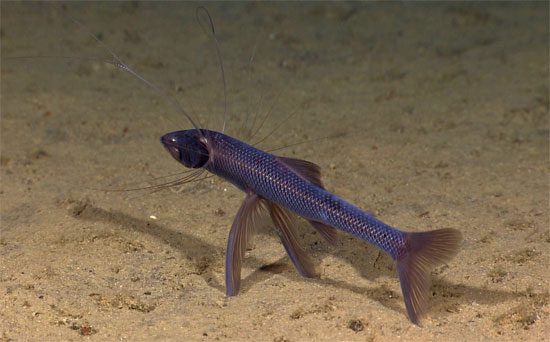
The Three-Legged Fish is one of the few sessile animals. Like corals, sponges, sea anemones, and some other marine creatures, they remain stationary, waiting for plankton to drift close enough to attack. Their three fins are very thin and elongated, allowing them to maintain their position in the deep ocean. The Three-Legged Fish only moves when absolutely necessary, using their two front fins to capture and maneuver food into their mouths.
Due to their lack of need to chase prey, the eyes of the Three-Legged Fish are nearly blind. Additionally, they are hermaphroditic, so they do not live in schools and rarely encounter other individuals of the same species.
Stargazer Fish

The Stargazer fish, known scientifically as Pleuroscopus pseudodorsalis, typically inhabits depths of 40-800 meters below the sea surface and can grow between 18-90 centimeters in length.
With jagged, sharp teeth and fierce-looking eyes, the Stargazer is also considered one of the ugliest fish in the world.
As a stealthy predator, the Stargazer’s upturned face allows it to hide most of its body under sand or mud, waiting for prey to swim close. When it opens its mouth, the Stargazer can transform into a “killing pit”, capable of swallowing prey of similar size in one gulp.
Some Stargazer species can even suck in prey using their long tongues. Others possess venomous spines behind their heads or electric organs located between their eyes, which serve as weapons to paralyze smaller prey or inflict pain on larger ones.
Mudskipper
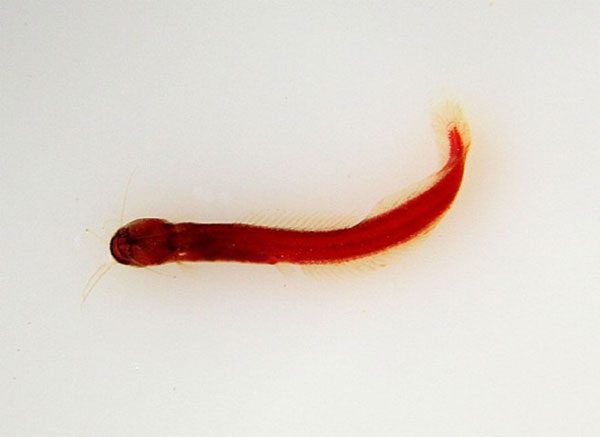
Belonging to the family Phreatobius, Mudskippers are rare and quite mysterious creatures. They are the only fish species that do not live underwater and often crawl on damp leaf piles along stream banks. Their skin is pink and slimy, and due to their primarily underground lifestyle, their eyes are nearly blind.
Tonguefish

The title of “the strangest vertebrate in the world” belongs to the Tonguefish. At birth, they appear relatively normal. However, as they grow, the skull of the Tonguefish begins to deform. Eventually, both of their eyes end up on one side of their body. This anatomical feature allows this peculiar fish to lie flat, camouflaging as a carpet capable of carnivorous behavior.
The pectoral fins of the Tonguefish gradually diminish over time. Most have elongated lips or snouts surrounding their jaws, making their mouths resemble a toothless hole, allowing them to catch prey from both sides of their bodies.
Moonfish
The Moonfish, scientifically known as Mola Mola, is a large marine fish that usually dives into deep waters where temperatures are very low.
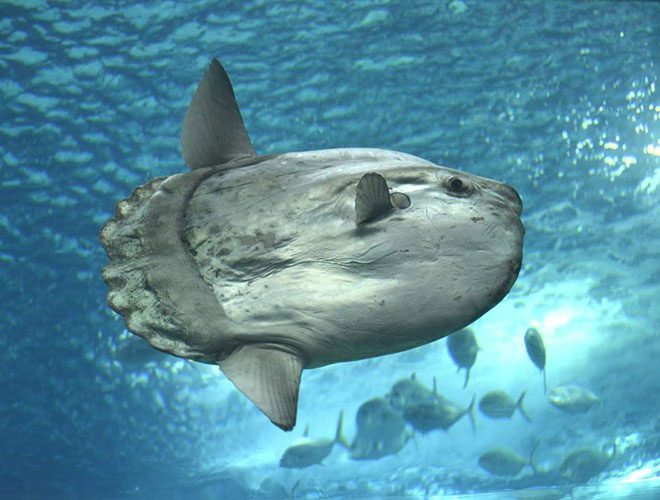
This species has a rather peculiar shape, with an oval body that is rounded at the front and flattened toward the tail. Their body length can reach between 3.5 to 5.5 meters. Notably, the mouth of this fish is very small, with each jaw possessing two teeth fused together, forming a beak. Due to this unusual mouth structure, they cannot swallow large prey and primarily feed on small crustaceans and other plankton.
A mother Moonfish can lay up to 300 million eggs just three weeks after pregnancy. The hatchlings are only slightly larger than a grain of sand, being 600 times smaller than their mother’s body. However, the young Moonfish grow very quickly, and within 15 months of hatching, they can reach a weight of up to 373 kilograms.
In their youth, Moonfish, like many other fish species, swim vigorously in schools. As they mature, they become increasingly lethargic, living solitary lives and allowing their bodies to drift with ocean currents across the seas.
Wobbegong Shark
This species lives in the coral reefs off the northern coast of Australia, New Guinea, and nearby islands and is known as one of the “strangest” sharks on earth.
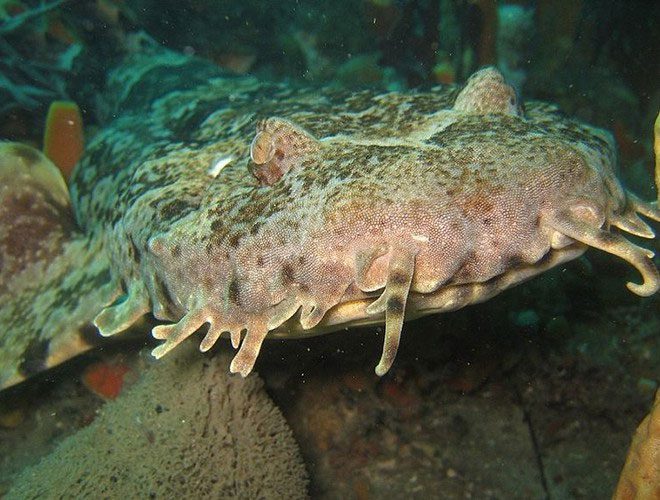
The Wobbegong has a relatively large, flattened body with mottled skin coloration and whisker-like features around its mouth, earning it the name carpet shark.
The Wobbegong Shark is dubbed the “master of camouflage” on the ocean floor. Utilizing its mottled skin and whiskers resembling seaweed, it disguises itself as coral, blending into the sandy ocean bed.
The shark’s trick is to lie still beneath the sand, and when an unsuspecting prey approaches within range, it swiftly attacks by opening its mouth wide and quickly closing it to prevent the prey from escaping.
Currently, the Wobbegong Shark is classified as a Near Threatened species.
Anglerfish
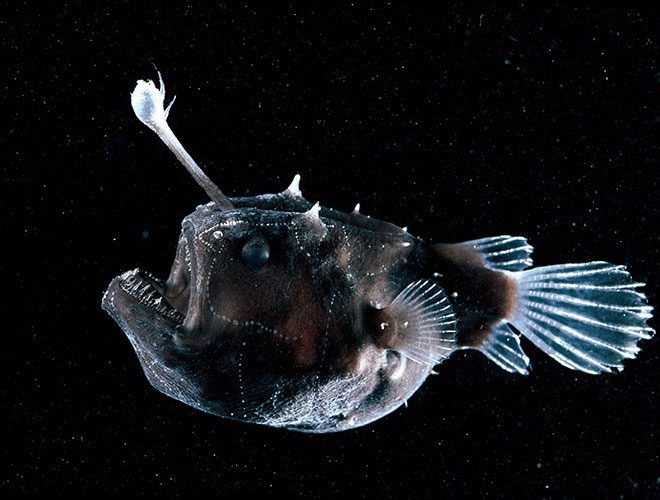
This fish belongs to the Lophiiformes order and inhabits deep waters in the Atlantic and Pacific Oceans.
The Anglerfish possesses a bizarre body shape with an oversized head, an unusually large upper jaw that can fold down to engulf the lower jaw, and a natural “fishing rod” on top of its head.
The “fishing rod” of the Anglerfish lures prey into its mouth. With expandable jaws and stomachs, Anglerfish can digest prey that is twice their size.
The Anglerfish’s unattractive appearance is its advantage, allowing it to hide and wait for prey to wander into its mouth. Known for its “extreme” hunting abilities, this fish is often referred to as the “monster” of the deep sea.
Red-lipped Batfish
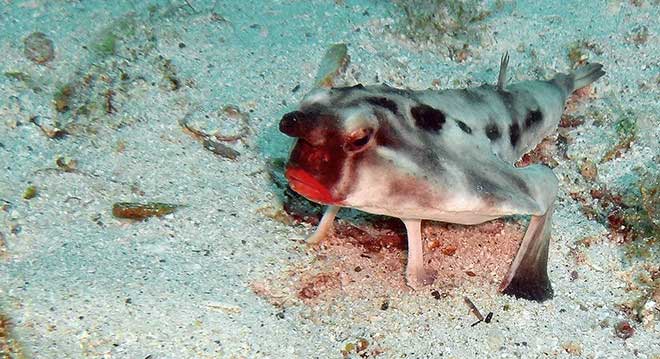
The Red-lipped Batfish, scientifically named Ogcocephalus darwini, is found in the deep waters around the Galapagos Islands in the Pacific Ocean and off the coast of Peru.
As the name suggests, the Red-lipped Batfish has peculiar red lips, a flat, broad body, and fins that resemble bat wings. Their red lips can be used to attract mates or for camouflage while hunting.
As they mature, the dorsal fins of the Red-lipped Batfish develop to resemble a finger on their heads. According to scientists, this fin is used to attract and “trap” prey. Their diet consists of fish, shrimp, and crustaceans.
Blobfish
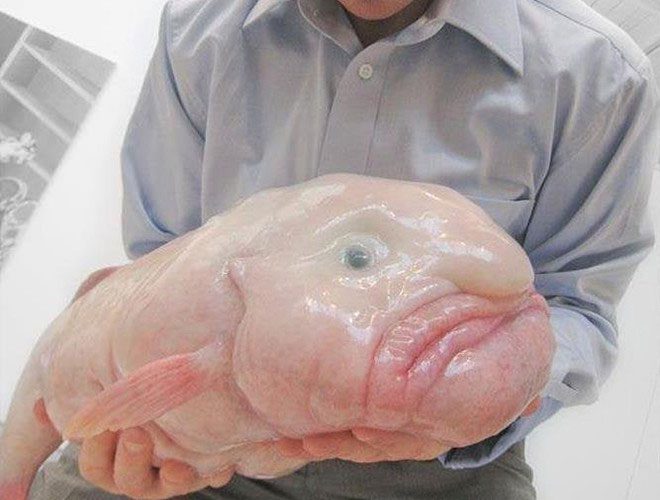
The Blobfish, known scientifically as Psychrolutes marcidus, is a deep-sea fish found in temperate waters. Their habitat is located in the deep sea off the coast of mainland Australia (Broken Bay), New South Wales, Tasmania, and some deep waters in New Zealand.
The appearance of this fish has been compared to the character Jabba the Hutt from the Star Wars movies, making it one of the ugliest species in the world. The blobfish has a pale pink or white skin. When viewed from the side, it resembles the face of a chubby man with a grumpy expression and a bulbous nose.
The body of the blobfish is made up of gelatinous masses that are less dense than water, allowing them to float near the ocean floor and withstand enormous pressure. Blobfish are known for their lazy movement; they simply drift in the water, waiting for prey to pass by before swallowing it whole.
Goblin Shark

The goblin shark is also considered one of the strangest fish on the planet.
Regarded as a prehistoric monster, it is the last surviving member of the Mitsukurinidae family, which dates back more than 125 million years.
As a deep-sea shark, the goblin shark possesses an extremely ugly and fearsome appearance, characterized by its long, beak-like snout. Additionally, it has a pink body and sharp teeth capable of crushing any prey.


















































